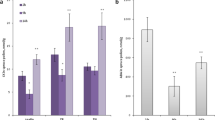Abstract
The hydroxyproline content of developing Zea mays (maize) pollen was determined. The level of hydroxyproline in uninucleate microspores early in pollen development was low (0.004% of dry weight). In contrast, mature pollen is enriched for this amino acid (0.1% of dry weight). In mature pollen, 90% of the hydroxyproline is in the soluble fraction. Upon in vitro pollen germination, hydroxyproline associated with the insoluble fraction increased from 10% to 26% of the total hydroxyproline. Antibodies specific to extensins and arabinogalactan proteins (AGPs), two major classes of hydroxyproline-containing proteins, recognized two distinct groups of proteins in maize pollen by Western analysis. The two types of pollen hydroxyproline-containing proteins could also be distinguished based on their behavior upon anion exchange chromatography.
Similar content being viewed by others
References
Bedinger PA, Edgerton MD (1990) Developmental staging of maize microspores reveals a transition in developing microspore proteins. Plant Physiol 92:474–479
Bloom H, Beier H, Gross HS (1987) Improved silver staining of plant proteins, RNA and DNA in polyacrylamide gels. Electrophoresis 8:93–99
Cassab GI, Varner JE (1987) Immunocytolocalization of extensin in developing soybean seed coats by immunogold-silver staining and by tissue printing on nitrocellulose paper. J Cell Biol 105:2581–2588
Chay CH, Buehler EG, Thorn JM, Whelan TM, Bedinger PA (1992) Purification of maize pollen exines and analysis of associated proteins. Plant Physiol 100:756–761
Chrispeels MJ (1969) Synthesis and secretion of hydroxyproline containing macromolecules in carrots. I. Kinetic analysis. Plant Physiol 44:1187–1193
Dashek WV, Harwood HI (1974) Proline, hydroxyproline, and lily pollen tube elongation. Ann Bot 38:947–959
Dougall DK, Shimbayashi K (1960) Factors affecting growth of tobacco callus tissue and its incorporation of tyrosine. Plant Physiol 35:396–404
Drozdz M, Kucharz E, Szyja J (1976) A colorimetric micromethod for determination of hydroxyproline in blood serum. Z Med Labortechn 17:163–171
Heslop-Harrison, J (1987) Pollen germination and pollen-tube growth. In: Giles KL, Prakash J (eds) Pollen: cytology and development (Inter Rev Cytol, vol 107) Academic Press, Orlando London, pp 1–78
Hood EE, Shen QX, Varner JE (1988) A developmentally regulated hydroxyproline-rich glycoprotein in maize pericarp cell walls. Plant Physiol 87:138–142
Hood KR, Baasiri RA, Fritz SE, Hood EE (1991) Biochemical and tissue print analyses of hydroxyproline-rich glycoproteins in cell walls of sporophytic maize tissues. Plant Physiol 96:1214–1219
Hood EE, Murphy JM, Pendleton RC (1993) Molecular characterization of maize extensin expression. Plant Mol Biol 23:685–695
Kieliszewski M, Lamport DTA (1987) Purification and partial characterization of a hydroxyproline-rich glycoprotein in a graminaceous monocot, Zea mays. Plant Physiol 85:823–827
Kieliszewski MJ, Leykam JF, Lamport DTA (1990) Structure of the threonine-rich extensin from Zea mays. Plant Physiol 92:316–326
Kieliszewski MJ, Kamyab A, Leykam JF, Lamport DTA (1992) A histidine-rich extensin from Zea mays is an arabinogalactan protein. Plant Physiol 99:538–547
Knox RB, Heslop-Harrison J (1976) Pollen-wall proteins: localization and enzymic activity. J Cell Sci 6:1–27
Knox RB, Vithanage HIMV, Howlett BJ (1980) Botanical immunocytochemistry: a review with special reference to pollen antigens and allergens. Histochem J 12:247–272
Lamport DTA (1965) The protein component of primary cell walls. Adv Bot Res 2:151–218
Lamport DTA, Northcote DH (1960) Hydroxyproline in primary cell walls of higher plants. Nature 188:665–666
Li YQ, Croes AF, Linskens HF (1983) Cell wall proteins in pollen and roots of Lilium longiflorum: extraction and partial characterization. Planta 158:422–427
Li YQ, Bruun L, Pierson ES, Cresti M (1992) Periodic deposition of arabinogalactan epitopes in the cell wall of pollen tubes of Nicotiana tabacum L. Planta 188:532–538
Pennell RI, Knox JP, Scofield GN, Selvendran RR, Roberts K (1989) A family of abundant plasma membrane-associated glycoproteins related to the arabinogalactan proteins is unique to flowering plants. J Cell Biol 108:1967–1977
Rae AL, Harris PJ, Bacic A, Clarke AE (1985) Composition of the cell walls of Nicotiana alata Link et Otto pollen tubes. Planta 166:128–133
Roberts K (1989) The plant extracellular matrix. Curr Opin Cell Biol 1:1020–1027
Sadava D, Chrispeels MJ (1971) Intracellular site of proline hydroxylation in plant cells. Biochemistry 10:4290–4294
Schaffner W, Weissmann C (1973) A rapid, sensitive, and specific method for the determination of protein in dilute solution. Anal Biochem 56:502–514
Showalter AM (1993) Structure and function of plant cell wall proteins. Plant Cell 5:9–23
Showalter AM, Varner JE (1989) Plant hydroxyproline-rich glyproteins. In: Stumpf PK, Conn EE (eds) The biochemistry of plants, vol 15. Academic Press, New York, pp 485–520
Stafstrom JP, Staehlin LA (1988) Antibody localization of extensin in cell walls of carrot storage roots. Planta 174:321–332
Stiefel V, Perez-Grau L, Albericio F, Giralt E, Ruiz-Avila L, Ludevid MD, Puigdomenech P (1988) Molecular cloning of cDNAs encoding a putative cell wall protein from Zea mays and immunological identification of related polypeptides. Plant Mol Biol 11:483–493
Zelles L (1975) Aminosäuregehalt des wachsenden Pollenschlauches von Pinus silvestris. Biochem Physiol Pflanz 167:115–119
Author information
Authors and Affiliations
Rights and permissions
About this article
Cite this article
Rubinstein, A.L., Prata, R.T.N. & Bedinger, P.A. Developmental accumulation of hydroxyproline and hydroxyproline-containing proteins in Zea mays pollen. Sexual Plant Reprod 8, 27–32 (1995). https://doi.org/10.1007/BF00228759
Received:
Accepted:
Issue Date:
DOI: https://doi.org/10.1007/BF00228759




